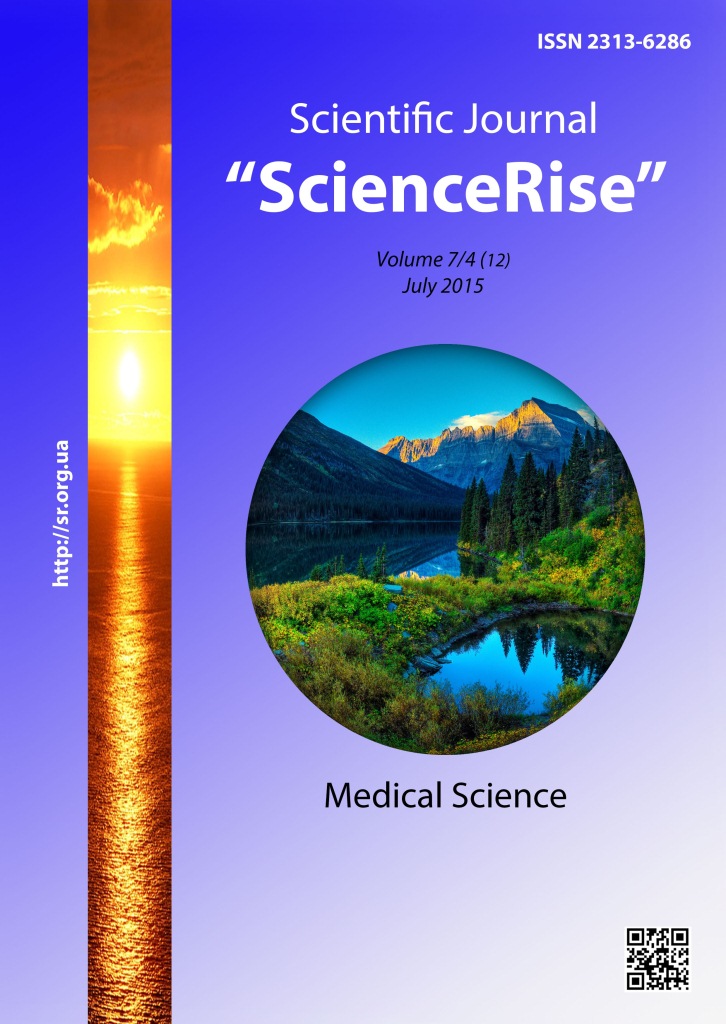Optimazation of antibiotic therapy in patients with chronic pyelonephritis combined with pancreatic diabetes of the 2 type by evaluation of the expression of plasmid resistance genes
DOI:
https://doi.org/10.15587/2313-8416.2015.47376Keywords:
chronic pyelonephritis, pancreatic diabetes of the 2 type, antibiotic therapy, resistance, plasmids, genes.Abstract
The resistance caused by the transfer of resistance genes among the uropathogenes with a help of plasmids in the treatment of chronic pyelonephritis (CP) combined with pancreatic diabetes (PD) of the 2 type increased last years. The aim of research was an optimization of methods of differentiated prescription of antibiotic therapy (ABT) for patients with CP and contaminant PD of the 2 type depending on expression of plasmid-induced genic mechanisms of antibiotic resistance.
Methods. There were examined 105 patients with chronic pyelonephritis, 73 of them – against the background of PD of the 2 type. The sensitivity of isolated cultures to antibiotics was carried out by the disco-diffuse method of Bauer-Kirbi on the medium of Hinton-Muller using commercial discs. The study of plasmid-induced mechanisms of resistance was carried out by the method of polymerase chain reaction (PCR).
Results. Detectability of plasmid-induced mechanisms in patients with CP and PD of the 2 type is 31,5 %. Β-lactamase of extended spectrum (βLES) – were the most diffuse detected genes. The highest inhibitory activity against the strains with plasmid genes was shown by meropenem, fosfomicyn, nitroxolinum, 4th generation of cephalosporins and the 3th generation of fluoroquinolones. According to received results it was elaborated an algorithm of differentiated prescription of ABT for patients with CP and PD of the 2 type depending on expression of plasmid-induced resistance genes.
Conclusions. There was studied the prevalence of plasmid-induced resistance mechanisms and elaborated the methods for increase an efficiency of empirical ABT for patients with CP and contaminant PD of the 2 type.
References
Kolesnik, M. O, Saydakova, N. A., Kozlyuk, N. I., Nikolaenko, S. (2013). Medical and preventive care to patients Nephrology Profile 2009-2012 what should to do next? Ukrainian Journal of Nephrology and Dialysis, 3 (39), 3–14.
Kolesnik, N. A. (2009). Kidneys and Diabetes: from understanding the problem to timely and adequate therapy. Ukrainian Journal of Nephrology and Dialysis, 13–14, 13–15.
Srinivas M., Chandrashekar UK., Shivashankara, K. N., Pruthvi, B. C. (2014). Clinical profile of urinary tract infections in diabetics and non-diabetics. AMJ, 7 (1), 29–34. doi: 10.4066/amj.2014.1906
Kolesnik, M. O., Stepanova, N. (2007). Etiological range of urinary tract infections. Ukrainian Journal of Nephrology and Dialysis, 3 (15), 16–29.
Carattoli, A. (2011). Plasmids in Gram negatives: Molecular typing of resistance plasmids. International Journal of Medical Microbiology, 301 (8), 654–658. doi: 10.1016/j.ijmm.2011.09.003
Kolesnik, M. O., Dudar, I., Stepanova, N. et al. (2012). Adapted clinical instruction for the better practice of diagnosis, treatment and prevention of urinary tract infections in women. Ukrainian Journal of Nephrology and Dialysis, 2 (34), 53–77.
Curcio, D. (2013). Multidrug-Resistant Gram-Negative Bacterial Infections: Are you Ready for the Challenge? Curr Clin Pharmacol., 12, 13–22.
Valenza, G., Nickel, S., Pfeifer, Y. (2014). Extended-Spectrum-β-Lactamase-Producing Escherichia coli as Intestinal Colonizers in the German Community. Antimicrob Agents Chemother., 58 (2), 1228–1230.
Poirel, L., Cattoir, V., Nordmann, P. (2012). Plasmid-Mediated Quinolone Resistance; Interactions between Human, Animal, and Environmental Ecologies. Frontiers in Microbiology, 3 (24), 1–7. doi: 10.3389/fmicb.2012.00024
Kolesnik, M. O., Dudar, I., Stepanova, N. et al. (2013). Classification of the urinary tract diseases for nephrological practice. Ukrainian Journal of Nephrology and Dialysis, 4 (40), 3–7.
Sundsfjord, A. (2005). Genetic methods for detection of antimicrobial resistance. DAHLAPMIS, 12, 815–837.
Grabe, M. (2015). Guidelines on Urological Infections. European Association of Urology, 182.
Søraas, A., Sundsfjord, A., Jørgensen, S. B., Liestøl, K., Jenum, P. A. (2014). High Rate of Per Oral Mecillinam Treatment Failure in Community-Acquired Urinary Tract Infections Caused by ESBL-Producing Escherichia coli. PLoS ONE, 9 (1), e85889. doi: 10.1371/journal.pone.0085889
Frakking, F. N., Rottier, W. C., Dorigo-Zetsma, J. W., van Hattem, J. M. et al. (2013). Appropriateness of empirical treatment and outcome in bacteremia caused by extended-spectrum-β-lactamase-producing bacteria. Antimicrob Agents Chemother., 57 (7), 3092–3099.
Downloads
Published
Issue
Section
License
Copyright (c) 2015 Ольга Игоревна Чуб, Александр Викторович Бильченко

This work is licensed under a Creative Commons Attribution 4.0 International License.
Our journal abides by the Creative Commons CC BY copyright rights and permissions for open access journals.
Authors, who are published in this journal, agree to the following conditions:
1. The authors reserve the right to authorship of the work and pass the first publication right of this work to the journal under the terms of a Creative Commons CC BY, which allows others to freely distribute the published research with the obligatory reference to the authors of the original work and the first publication of the work in this journal.
2. The authors have the right to conclude separate supplement agreements that relate to non-exclusive work distribution in the form in which it has been published by the journal (for example, to upload the work to the online storage of the journal or publish it as part of a monograph), provided that the reference to the first publication of the work in this journal is included.

